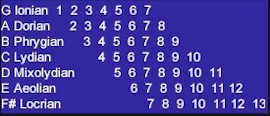Scroll through the lesson and click on notation/video/audio links to load the interactive players.
Please subscribe to get full access to all lessons for only $7.95/month PLUS 1 week free trial.

Riff Interactive lessons are
LESS expensive and
MORE interactive than alternatives!
More Info
|
|

Understanding The Modes - part 2
sample riffs 2
Lyle: In lesson part 1 you learned all the
modes using the E note as your root, or starting note.
In theory, you were changing keys each time you went to a new mode.
The purpose of part 1 was to see and hear the difference of the Modes compared
to each other. In this lesson, you'll learn a different
approach to using the modes. The Modes you'll be working with in this
lesson will be directly related to the key of G.
Modes are scales that are "inside" the major scale.
If you took a major scale but started on the 2nd note and played 1 octave higher
(to the 9th) you would have the Dorian mode or the 2nd mode.
Take a look at this mode chart. You'll see that each mode starts off the next
interval of the major scale.
chart 1

Lyle: You're still playing the same notes of
the major scale, just in a different order, which gives you a different sound.
The shift of whole-steps and half-steps have changed when you started on the 2nd
resulting in a minor type of scale.
Lyle: The purpose of learning and using modes
are: 1. Applying the appropriate scale over
chords, 2. Helping you to find other places on
the neck to play, 3. Forcing different tonalities between
the maj and min modes. We'll learn patterns and listen to
examples in this lesson. Here's a jam track for you to use:
Looping Sound
Clip 1
Lyle:
This is in the key of G. Here's the chords for the jam track:
Lyle:
There are 7 modes you can use for this jam in G, here's the first mode:
Lyle:
The Ionian - it's a major scale! Here's a solo made up from this pattern:
Lyle:
Here's a video of that Ionian solo:
Ionian solo
Lyle:
The next mode is the Dorian minor based of the 2nd note in the G major scale:
Lyle:
Here's a solo using the A Dorian minor mode:
Lyle:
Next is the Phrygian minor, from the 3rd note in the G major scale:
Lyle:
Now you're up at the 7th fret position playing a pattern that still is in the
key of G! Here's a solo using this pattern:
Lyle:
Next is the 4th mode, Lydian:
Lyle:
The C Lydian is like playing from C to C inside the G major
scale. Here's a solo using this pattern:
Lyle:
So many times I get students asking how to "bust out' from using the same scales
they always seem to use. Most people learn the pentatonic scales and
end up just using them. With modes you can get away from
that.
Lyle: The 5th mode is the
Mixolydian, starting on D in the G major scale and
going up an octave.
Lyle:
The D Mixolydian is the type of mode you could play over a D7
chord. Here's a solo with this pattern at the 10th fret:
Lyle:
Notice how each one of these mode patterns gives you a new place on the neck to
play. You're still using the same notes each
time, but the starting and ending points are different, giving your sound and fingers new places
to explore. Next is the E Aeolian minor based of the 6th note in the major
scale:
Lyle:
The Aeolian minor is also called the "relative minor". Other names are: natural or pure
minor. Here's a solo using this pattern at the 12th fret:
Lyle:
The last mode is the Locrian minor. It starts on the 7th or last note of the
major scale:
Lyle:
Here's a solo using this pattern:
Lyle:
What you've just learned is the 7 modes in the key of G major and solos made
from each basic finger pattern. Notice how it moved you up the neck? We
started at the 3rd fret and worked our way up. Each mode gave us a new place to play on
the neck and they were all related to the key we were in.
Frank: Does
it matter which mode we use during the chord structure other than
feel?
Lyle: It doesn't
matter! They all are related to the G major
scale! Imagine using only the minor pentatonic
scale to solo with over this jam? It would start sounding
predictable.
Lyle:
Look at this pattern on two strings, it's all the notes from the modes we just
covered on just the 1st and 2nd strings:
Lyle:
Here's a solo using each mode, 1 at a time, during each measure:
Lyle:
Here's a video clip of this solo:
2 string solo
Lyle:
Take your time when trying to understand the modes. It takes a few tries and then one day,
you'll see the light! Next lesson I'll use more examples of
the modes and where and when to use
them.
Lyle:
Let's take a break for now. If you would like further study on this topic or any
other topic, email me at
Lyle@theguitar.net for info on how you can get your own customized guitar
lessons like this using Riff Interactive technology. Your private lessons can be
downloaded to your pc for anytime, anywhere study. I can even teach you how to
play your favorite songs! Thanks and see you at the next lesson. - Lyle
|
<< load notation from left
|
|
<< load audio from left
|
<< load audio from left
|